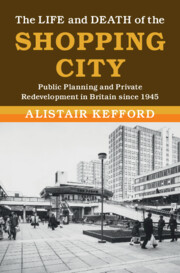 The Life and Death of the Shopping City
The Life and Death of the Shopping City Book contents
- The Life and Death of the Shopping City
- Modern British Histories
- The Life and Death of the Shopping City
- Copyright page
- Dedication
- Contents
- Figures
- Acknowledgements
- Introduction
- 1 Reconstructing Retail in the 1940s
- 2 Cities in the Age of Affluence
- 3 Making the Modern Shopping City
- 4 The Politics of Partnership
- 5 Landscapes of Leisure
- 6 Demand and Discontent in the Shopping City
- 7 Triumph of the Shopping City
- Conclusion
- List of Archives and Abbreviations
- Bibliography
- Index
Conclusion
Published online by Cambridge University Press: 31 March 2022
- The Life and Death of the Shopping City
- Modern British Histories
- The Life and Death of the Shopping City
- Copyright page
- Dedication
- Contents
- Figures
- Acknowledgements
- Introduction
- 1 Reconstructing Retail in the 1940s
- 2 Cities in the Age of Affluence
- 3 Making the Modern Shopping City
- 4 The Politics of Partnership
- 5 Landscapes of Leisure
- 6 Demand and Discontent in the Shopping City
- 7 Triumph of the Shopping City
- Conclusion
- List of Archives and Abbreviations
- Bibliography
- Index
Summary
At the beginning of the twenty-first century, the position of the shopping city model at the heart of UK urban policy and planning seemed fully assured. The New Labour government elected in 1997 recast the urban regeneration agenda under a new rubric of ‘urban renaissance’, with a greater emphasis upon social provision and community initiatives, but the prevailing economic and developmental model for urban centres remained shopping-centred and property-led.1 Indeed, the impetus provided by the renaissance agenda combined with a wider climate of economic optimism and expansion around the turn of the century to see a marked intensification of retail development activity in many cities. In Birmingham, for example, the Bull Ring shopping centre was levelled and rebuilt at a cost of £500 m, reopening in 2003 with a ‘distinctive curved exterior’ and a cladding of striking metallic discs that made it ‘Birmingham’s most photographed building’.
- Type
- Chapter
- Information
- The Life and Death of the Shopping CityPublic Planning and Private Redevelopment in Britain since 1945, pp. 312 - 318Publisher: Cambridge University PressPrint publication year: 2022
